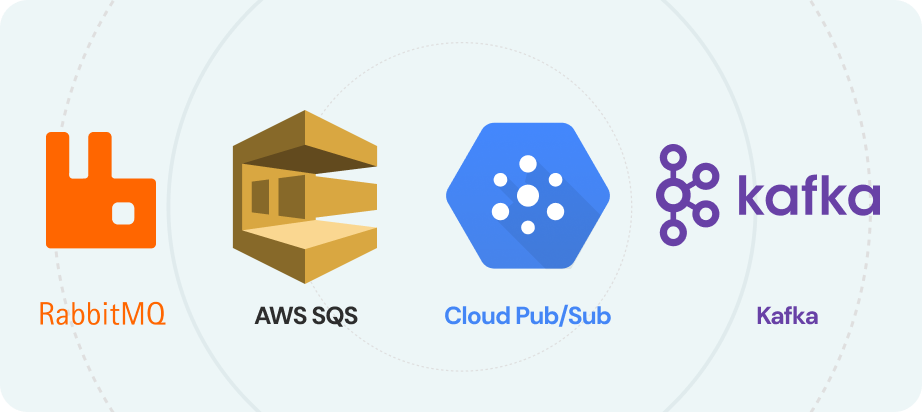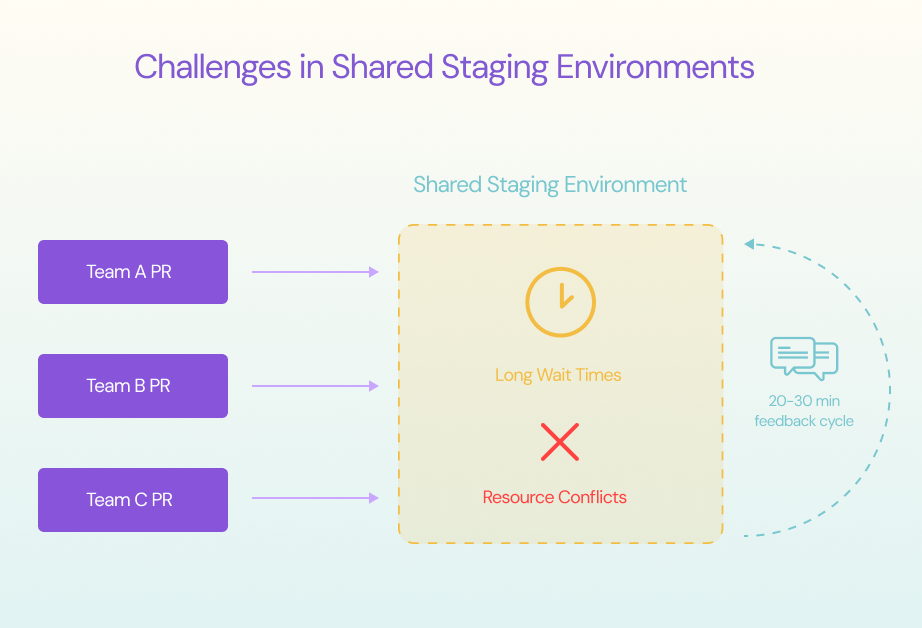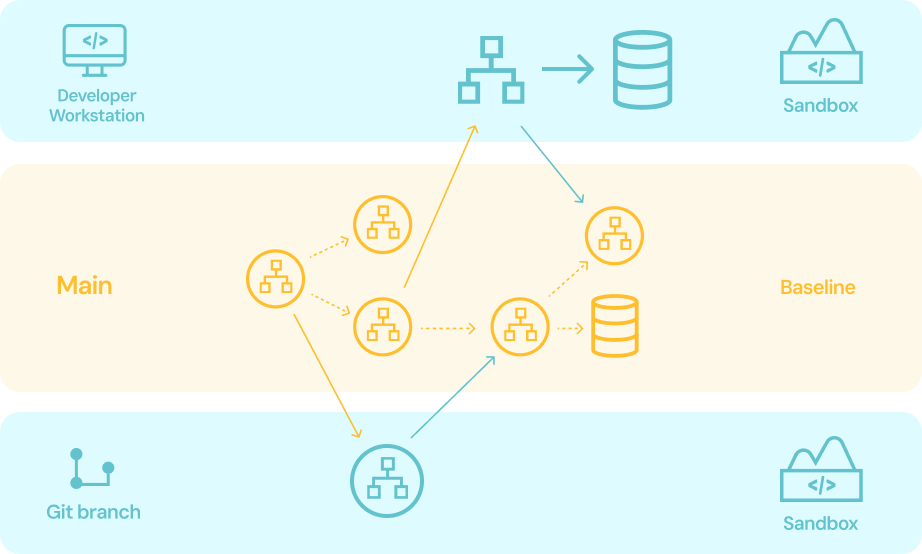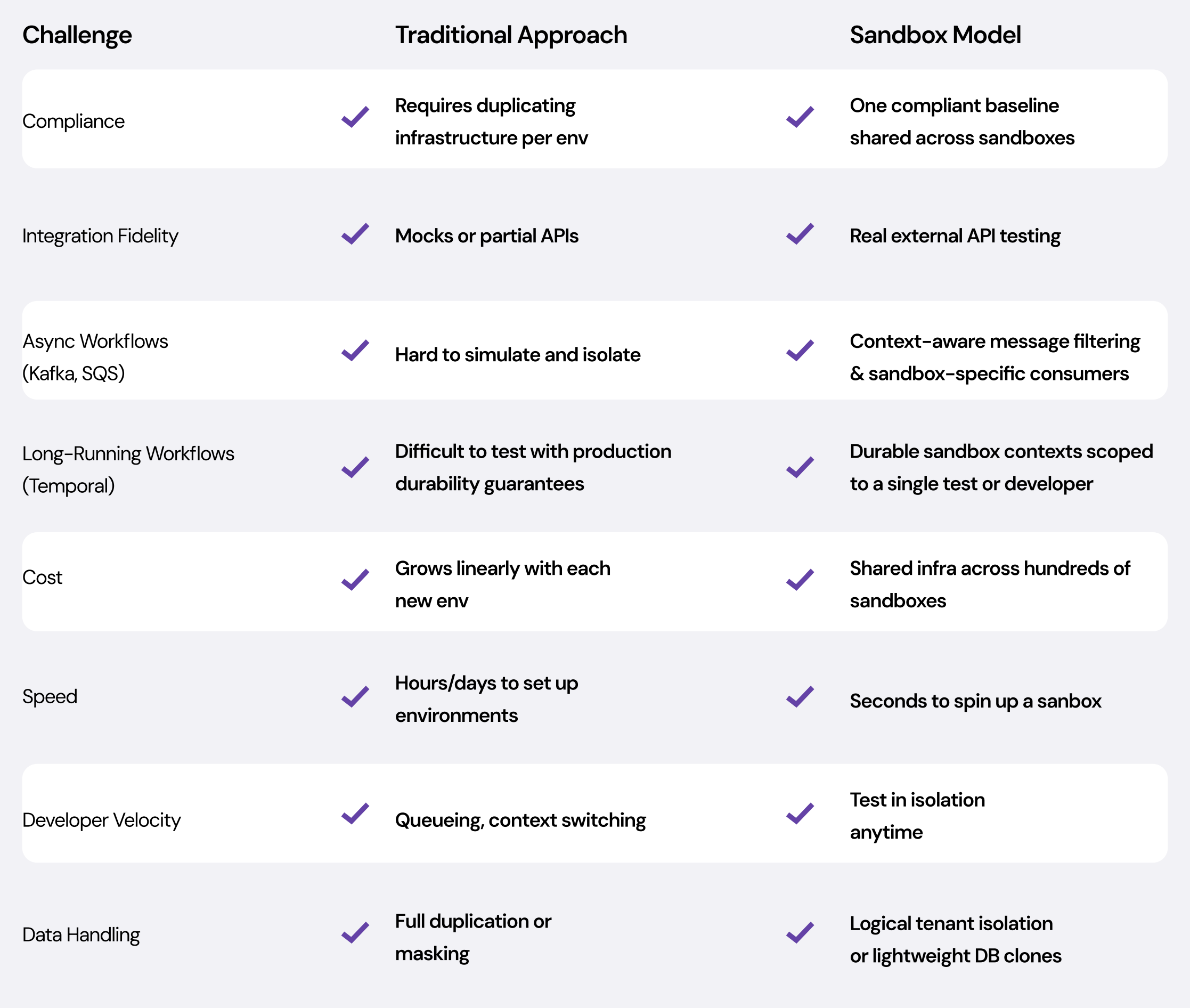Breaking the Staging Bottleneck: Scalable Microservices Testing for FinTech
Executive Summary
In FinTech, testing isn’t just about software quality—it’s about safeguarding customer trust, ensuring regulatory compliance, and enabling secure innovation. But the rise of microservices architectures has exposed fundamental flaws in traditional testing workflows—especially staging environments. As FinTech organizations scale, the cost, complexity, and inefficiencies of infrastructure-heavy testing environments become unsustainable.
This white paper explores the evolution of testing strategies in FinTech and introduces a new solution:Kubernetes-native sandbox environments. These lightweight, production-like testing spaces offer compliance-ready isolation without duplicating infrastructure—unlocking speed, scalability, and precision.With real-world examples from leading organizations like Brex, Earnest, and DoorDash, we demonstrate how the sandbox model is redefining how FinTech teams test microservices.
1. The FinTech Imperative: Trust, Compliance, and Speed
FinTech applications operate in a uniquely high-stakes environment. They manage sensitive customer data, execute financial transactions, and rely on intricate integrations with external APIs, such as payment processors and fraud detection systems. In this context, software bugs aren’t just inconvenient—they pose serious risks, including financial loss, reputational damage, and regulatory violations. That’s why high-fidelity testing environments are essential in FinTech. They ensure that every new feature, update, or workflow behaves correctly before reaching production, reducing the risk of costly errors.
However, testing in FinTech comes with a distinct set of challenges. Regulatory frameworks such as PCI DSSand GDPR impose strict requirements around data handling, access controls, and system auditing. These constraints make it nearly impossible to simply clone production environments or data. Additionally, FinTech systems often depend on real-world, external services—including banking networks and payment gateways—that introduce unpredictable behaviors like rate limiting, timeouts, and service outages. These interactions must be tested in realistic conditions to ensure reliability. At the same time, every action in a testing environment must meet security and auditability standards, which adds further complexity.
Historically, staging environments have played a critical role in addressing these challenges. Designed to replicate production conditions, they’ve been the go-to solution for validating functionality and compliance.But as FinTech systems grow more complex and teams scale, the traditional staging model is showing its limits. Maintaining multiple production-like environments is costly, difficult to synchronize, and increasingly prone to bottlenecks and delays. What was once a safety net is now becoming a drag on velocity and innovation.
2. The Microservices Testing Paradox
The shift from monolithic architectures to microservices has enabled software teams to achieve greateragility and scalability. In this new model, services are decoupled and independently deployable, allowingteams to move faster and scale specific parts of their systems without impacting others. This architecturalevolution has been especially appealing to FinTech companies looking to innovate quickly while managingcomplex systems. However, it has also introduced significant new testing challenges.
While unit testing continues to scale effectively in microservices environments—enabling developers to test components in isolation—integration testing becomes increasingly difficult. As services proliferate, interdependencies grow. A simple feature change may span multiple services, each potentially managed by different teams using different stacks. These cross-service interactions are a frequent source of failures.
Common issues include mismatched API versions, inconsistent data contracts, and hard-to-reproducebugs stemming from asynchronous workflows. Integration testing must account for all of these variables to ensure reliability, but doing so at scale is complex and time-consuming.
This is particularly challenging in FinTech systems, where asynchronous flows are everywhere: fraud detection triggers, payment settlement queues, webhook-driven notifications, and more. These workflows don’t follow a simple request-response pattern, which means bugs can emerge long after a request is made, and failures often surface far downstream from their root cause. Testing these flows reliably requires high fidelity environments and end-to-end visibility, which most teams lack in their current setup.

Recent industry data highlights the severity of the issue. According to the CNCF’s 2024 annual survey, 80%of respondents are running Kubernetes in production (cncf.org). Yet despite the widespread adoption, manyorganizations continue to struggle with testing. Moreover, developers in microservices organizations lose anestimated 8 to 10 hours per week (getdx.com) dealing with testing bottlenecks and context switching. For a200-person engineering team, that equates to approximately $400,000 in lost productivity each month.In FinTech, where trust, compliance, and speed are critical, these inefficiencies are unacceptable. Testingworkflows must scale effectively—catching integration issues early—without compromising on security, dataprivacy, or regulatory compliance. Traditional staging environments, designed for simpler, monolithic systems,were never built to handle the dynamic, large-scale demands of today’s FinTech microservices. As a result,many organizations are now searching for modern testing solutions that align with the realities ofmicroservices development. What FinTech teams need is a modern testing approach—one that supportsasynchronous workflows, deep service integration, and scalable developer autonomy, without compromisingcompliance or operational integrity.
3. Why Traditional Staging Breaks at Scale
As FinTech organizations scale, their testing needs become more complex—and traditional staging environments struggle to keep up. Most teams fall back on one of three common testing strategies, each with its own benefits but also critical limitations.
The first approach relies on mocks and unit tests, which are fast and easy to run. This method is popular because it allows developers to test individual components in isolation and get rapid feedback during the development cycle. However, this speed comes at the expense of realism. Mocks oversimplify service interactions and fail to capture the behavior of external systems like payment gateways, identity verification services, or fraud detection tools. As a result, many bugs go undetected until much later in the release process—often in production.
The second approach is to use shared staging environments, which aim to closely replicate production conditions by running all services together in a single environment. This setup improves test accuracy compared to mocks but introduces a new set of problems. Because the environment is shared across multiple teams, it’s prone to test collisions, data conflicts, and instability. When multiple developers deploy overlapping changes or run conflicting tests, issues arise that are difficult to trace and resolve. These bottlenecks create delays, reduce developer confidence, and increase the time required to validate changes.

The third and most comprehensive approach is environment duplication—creating a full copy of the staging environment for each team or use case. This strategy delivers high fidelity and strong isolation, making it easier to detect issues early and ensure test accuracy. However, the operational and financial costs are steep. Each environment must maintain compliance with regulations like PCI DSS and GDPR, which means provisioning isolated encryption keys, access controls, and secure audit logging. Additionally, these environments require unique configurations and connections to third-party APIs. As the number of environments grows, so does the complexity of managing and securing them.
In practice, each of these approaches introduces friction. Duplicating environments creates significant overhead and delays due to the need for specialized infrastructure. Mocking trades off realism and often results in runtime failures that escape early detection. Sharing environments leads to interference between teams, test flakiness, and slower feedback cycles—all of which hinder development velocity.
As one FinTech VP described their experience:
"We had dozens of staging environments, but debugging took days. There was always something out-of-sync, or a conflict we couldn’t reproduce.”
This quote reflects a broader industry trend: traditional testing strategies may have worked for simpler systems, but they fall apart under the scale, security demands, and interdependencies of modern FinTech. A more scalable, cost-effective, and developer-friendly testing model is needed to move forward.
4. A Paradigm Shift: The Sandbox Model

Sandbox environments offer a fundamentally different approach to testing microservices—one that breaks away from the infrastructure-heavy methods of the past. Rather than duplicating an entire application stack for every developer or test case, sandboxes isolate only the specific services under development. These services are then seamlessly integrated into a shared, high-fidelity baseline environment that mirrors production. This model dramatically reduces complexity and infrastructure costs while maintaining the realism and compliance needed in FinTech systems.
At the core of this approach is selective deployment. Developers no longer need to spin up the entire system to test a change. Instead, they deploy only the service they are actively working on. This minimizes resource usage and accelerates the development cycle, especially when working within complex, multi-service architectures.
Once deployed, request routing ensures that traffic is intelligently directed through the sandbox. Each request includes a sandbox identifier, which tells the system whether to route the call to the developer’s modified service or to the shared baseline version. This level of control allows for precise, per-sandbox behavior without duplicating the entire environment.
Context propagation is another critical capability of the sandbox model. As a request flows through multiple services in a microservices architecture, it carries the sandbox context with it. This ensures that the entire chain of service calls remains isolated within that sandbox, preserving the integrity of the test and avoiding cross-contamination with other developers’ work. The foundation for all of this is a shared baseline environment. This environment runs continuously, containing the latest stable versions of all services and complying with organizational security and regulatory standards.
By building on this shared baseline, sandboxes inherit its compliance posture, configuration, and connections to real external services—without requiring individual setups to replicate them. For FinTech teams, the benefits of this model are substantial. First, sandboxes inherit compliance from the shared environment. This means developers can test in production-like conditions without reconfiguring PCI DSS controls, audit logging, or encryption mechanisms. Second, sandboxes support real API integration. There’s no need to rely on mocks—teams can test against actual payment gateways, fraud tools, and banking APIs, capturing issues like rate limits and timeouts that often go undetected in simplified test setups.
Additionally, sandboxes provide fast feedback. Because they avoid full environment provisioning, developers can spin up a sandbox in seconds, test their changes, and iterate quickly. This speeds up the development loop and reduces time-to-release. Finally, the model is inherently audit-ready. All test activity remains within compliant boundaries, and sandbox-specific logs and headers allow for precise traceability—an essential requirement in any regulated FinTech environment.
In short, sandbox environments enable FinTech teams to test faster, smarter, and more securely—without sacrificing the realism or regulatory rigor their applications demand.
5. Real-World Use Cases: From Scaling to Security
Brex
Brex adopted sandbox testing via Signadot to support hundreds of developers while maintaining complianceand real API fidelity. They:

Earnest
Earnest integrated Signadot into their CI/CD pipelines to enable instant sandbox environments and automated end‑to‑end testing, giving developers real-time insights into service behavior and dramatically improving release reliability. This shift empowered dev teams to:

DoorDash
DoorDash’s developers use CLI-triggered sandbox environments, integrated with Istio for header-based routing. This self-service model enabled:

6. The Sandbox Advantage for FinTech

7. Implementation Considerations
Sandbox testing builds on technologies many FinTech teams already use. If you're running on Kubernetes and using tools like Istio, Linkerd, or an API gateway, you likely already have the core building blocks in place. Even without a service mesh, lightweight systems like Signadot’s DevMesh provide built-in routing and context management, making it easy to get started.
A key enabler is context propagation—passing a sandbox ID across service calls. This is made trivial by standards like OpenTelemetry, and in most interpreted languages (e.g., Java, Node.js, Python), auto instrumentation libraries mean no application-level changes are required. For event-driven systems likeKafka or SQS, sandbox IDs can be embedded in message headers to ensure isolation across async flows.
Data isolation is handled through existing multi-tenant patterns or ephemeral database clones. Most teams start by scoping data to sandbox-specific IDs and clone databases only for services that require deeper or destructive testing.
Sandboxes also integrate seamlessly with developer workflows. Engineers can spin up environments throughCLI tools or CI pipelines, deploy just the service they’re changing, and test against real dependencies.
Observability tools like Datadog and Grafana work out of the box, automatically tagging logs and traces by sandbox ID, so there’s nothing new to build.
With minimal setup, sandboxes deliver isolated, production-like environments that fit naturally into modernFinTech stacks—enabling fast, compliant testing without the overhead of full environment duplication.
8. Conclusion: Building Resilient FinTech Systems
As the FinTech landscape continues to evolve, systems are becoming increasingly interconnected. New partnerships, third-party APIs, and constantly changing regulatory requirements are raising the stakes for integration testing. In this environment, even a small misconfiguration or unnoticed compatibility issue between services can lead to serious consequences—ranging from failed transactions to compliance violations. As the complexity of these systems grows, so too does the cost of inadequate testing.
Unfortunately, traditional testing environments—whether shared staging environments or fully duplicated infrastructure—are no longer sufficient. Shared environments often lead to test interference, stale configurations, and bottlenecks that slow development. On the other hand, duplicating environments for every team or use case introduces prohibitive infrastructure costs, maintenance overhead, and compliance complexity. These legacy approaches cannot keep up with the speed, precision, or security required by modern FinTech development.
Sandbox environments offer a much-needed breakthrough. By providing isolated, production-like testing spaces built on top of a shared and compliant baseline, sandboxes deliver the best of both worlds. They allow developers to work autonomously while maintaining strict security and data boundaries. Developer scan test their services against real dependencies without impacting others, ensuring higher test fidelity without the cost of full duplication.
What sets sandboxes apart is their ability to align key objectives that are often at odds:
.png)
Ultimately, FinTech organizations that embrace sandbox testing gain a clear strategic advantage. They can release features with greater confidence, reduce bugs and delays, and maintain rigorous compliance—all while empowering developers to move quickly and safely. In a sector where trust, speed, and innovation are tightly linked, sandbox environments are becoming essential infrastructure for success.
About Signadot
Signadot is a Kubernetes-native testing platform purpose-built for microservices. It enables application layer sandbox environments, letting developers test their changes in isolated, production-like conditions without duplicating infrastructure. Signadot helps FinTech companies shift testing left, boost developer velocity, and maintain compliance without compromise.
Join our 1000+ subscribers for the latest updates from Signadot





